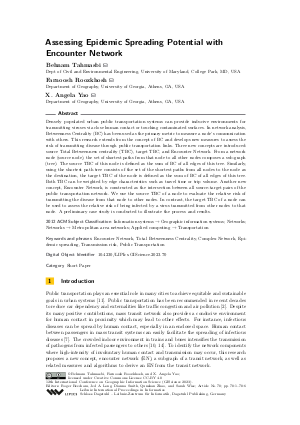Assessing Epidemic Spreading Potential with Encounter Network (Short Paper)
Authors Behnam Tahmasbi, Farnoosh Roozkhosh, X. Angela Yao
-
Part of:
Volume:
12th International Conference on Geographic Information Science (GIScience 2023)
Part of: Series: Leibniz International Proceedings in Informatics (LIPIcs)
Part of: Conference: International Conference on Geographic Information Science (GIScience) - License:
 Creative Commons Attribution 4.0 International license
Creative Commons Attribution 4.0 International license
- Publication Date: 2023-09-07
File

PDF
LIPIcs.GIScience.2023.70.pdf
- Filesize: 3.48 MB
- 6 pages
Document Identifiers
Subject Classification
ACM Subject Classification
- Information systems → Geographic information systems
- Networks
- Networks → Metropolitan area networks
- Applied computing → Transportation
Keywords
- Encounter Network
- Total Betweenness Centrality
- Complex Network
- Epidemic spreading
- Transmission risk
- Public Transportation
Metrics
- Access Statistics
-
Total Accesses (updated on a weekly basis)
0PDF Downloads0Metadata Views
Abstract
Densely populated urban public transportation systems can provide inducive environments for transmitting viruses via close human contact or touching contaminated surfaces. In network analysis, Betweenness Centrality (BC) has been used as the primary metric to measure a node’s communication with others. This research extends from the concept of BC and develops new measures to assess the risk of transmitting disease through public transportation links. Three new concepts are introduced: source Total Betweenness centrality (TBC), target TBC, and Encounter Network. From a network node (source node), the set of shortest paths from that node to all other nodes composes a sub-graph (tree). The source TBC of this node is defined as the sum of BC of all edges of this tree. Similarly, using the shortest path tree consists of the set of the shortest paths from all nodes to the node as the destination, the target TBC of the node is defined as the sum of BC of all edges of this tree. Both TBC can be weighted by edge characteristics such as travel time or trip volume. Another new concept, Encounter Network, is constructed as the intersection between all source-target pairs of the public transportation network. We use the source TBC of a node to evaluate the relative risk of transmitting the disease from that node to other nodes. In contrast, the target TBC of a node can be used to assess the relative risk of being infected by a virus transmitted from other nodes to that node. A preliminary case study is conducted to illustrate the process and results.
Cite As Get BibTex
Behnam Tahmasbi, Farnoosh Roozkhosh, and X. Angela Yao. Assessing Epidemic Spreading Potential with Encounter Network (Short Paper). In 12th International Conference on Geographic Information Science (GIScience 2023). Leibniz International Proceedings in Informatics (LIPIcs), Volume 277, pp. 70:1-70:6, Schloss Dagstuhl – Leibniz-Zentrum für Informatik (2023)
https://doi.org/10.4230/LIPIcs.GIScience.2023.70
BibTex
@InProceedings{tahmasbi_et_al:LIPIcs.GIScience.2023.70,
author = {Tahmasbi, Behnam and Roozkhosh, Farnoosh and Yao, X. Angela},
title = {{Assessing Epidemic Spreading Potential with Encounter Network}},
booktitle = {12th International Conference on Geographic Information Science (GIScience 2023)},
pages = {70:1--70:6},
series = {Leibniz International Proceedings in Informatics (LIPIcs)},
ISBN = {978-3-95977-288-4},
ISSN = {1868-8969},
year = {2023},
volume = {277},
editor = {Beecham, Roger and Long, Jed A. and Smith, Dianna and Zhao, Qunshan and Wise, Sarah},
publisher = {Schloss Dagstuhl -- Leibniz-Zentrum f{\"u}r Informatik},
address = {Dagstuhl, Germany},
URL = {https://drops.dagstuhl.de/entities/document/10.4230/LIPIcs.GIScience.2023.70},
URN = {urn:nbn:de:0030-drops-189657},
doi = {10.4230/LIPIcs.GIScience.2023.70},
annote = {Keywords: Encounter Network, Total Betweenness Centrality, Complex Network, Epidemic spreading, Transmission risk, Public Transportation}
}
Author Details
- Dept of Civil and Environmental Engineering, University of Maryland, College Park, MD, USA
References
-
Marc Barthélemy. Spatial networks. Physics reports, 499(1-3):1-101, 2011.

-
Paola Carolina Bueno, Juan Gomez, Jonathan R Peters, and Jose Manuel Vassallo. Understanding the effects of transit benefits on employees’ travel behavior: Evidence from the new york-new jersey region. Transportation Research Part A: Policy and Practice, 99:1-13, 2017.

-
Robin de Regt, Christian von Ferber, Yurij Holovatch, and Mykola Lebovka. Public transportation in great britain viewed as a complex network. Transportmetrica A: Transport Science, 15(2):722-748, 2019.

-
Martin G Everett and Stephen P Borgatti. The centrality of groups and classes. The Journal of mathematical sociology, 23(3):181-201, 1999.

-
Flavio Iannelli, Andreas Koher, Dirk Brockmann, Philipp Hövel, and Igor M Sokolov. Effective distances for epidemics spreading on complex networks. Physical Review E, 95(1):012313, 2017.

-
Qing-Chang Lu. Modeling network resilience of rail transit under operational incidents. Transportation Research Part A: Policy and Practice, 117:227-237, 2018.

-
Baichuan Mo, Kairui Feng, Yu Shen, Clarence Tam, Daqing Li, Yafeng Yin, and Jinhua Zhao. Modeling epidemic spreading through public transit using time-varying encounter network. Transportation Research Part C: Emerging Technologies, 122:102893, 2021.

-
Ahmad K Naimzada, Silvana Stefani, and Anna Torriero. Networks, topology and dynamics: Theory and applications to economics and social systems, volume 613. Springer Science & Business Media, 2008.

-
Prapanporn Rattana, Konstantin B Blyuss, Ken TD Eames, and Istvan Z Kiss. A class of pairwise models for epidemic dynamics on weighted networks. Bulletin of mathematical biology, 75:466-490, 2013.

-
Lijun Sun, Kay W Axhausen, Der-Horng Lee, and Xianfeng Huang. Understanding metropolitan patterns of daily encounters. Proceedings of the National Academy of Sciences, 110(34):13774-13779, 2013.

-
Behnam Tahmasbi and Hossein Haghshenas. Public transport accessibility measure based on weighted door to door travel time. Computers, Environment and Urban Systems, 76:163-177, 2019.

-
Riitta Toivonen, Jussi M Kumpula, Jari Saramäki, Jukka-Pekka Onnela, János Kertész, and Kimmo Kaski. The role of edge weights in social networks: modelling structure and dynamics. In Noise and Stochastics in Complex Systems and Finance, volume 6601, pages 48-55. SPIE, 2007.

-
Wei Wang, Ming Tang, Hai-Feng Zhang, Hui Gao, Younghae Do, and Zong-Hua Liu. Epidemic spreading on complex networks with general degree and weight distributions. Physical Review E, 90(4):042803, 2014.

-
Hai Yang and Hai-Jun Huang. Mathematical and economic theory of road pricing. Emerald Group Publishing Limited, 2005.

